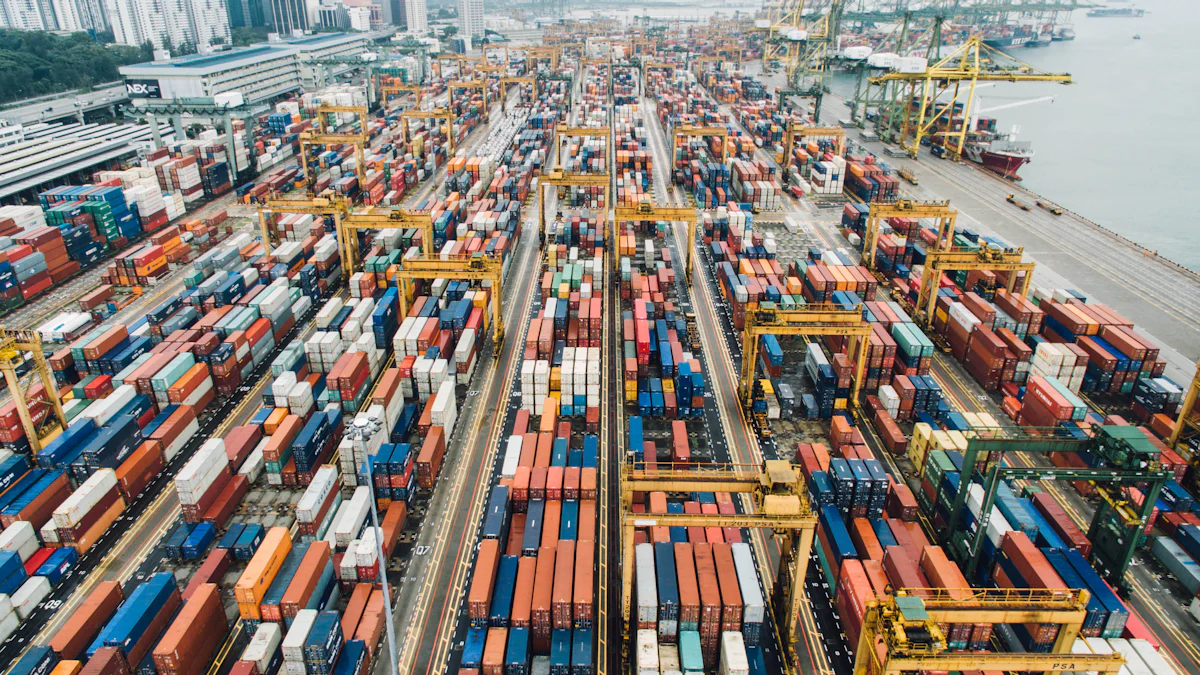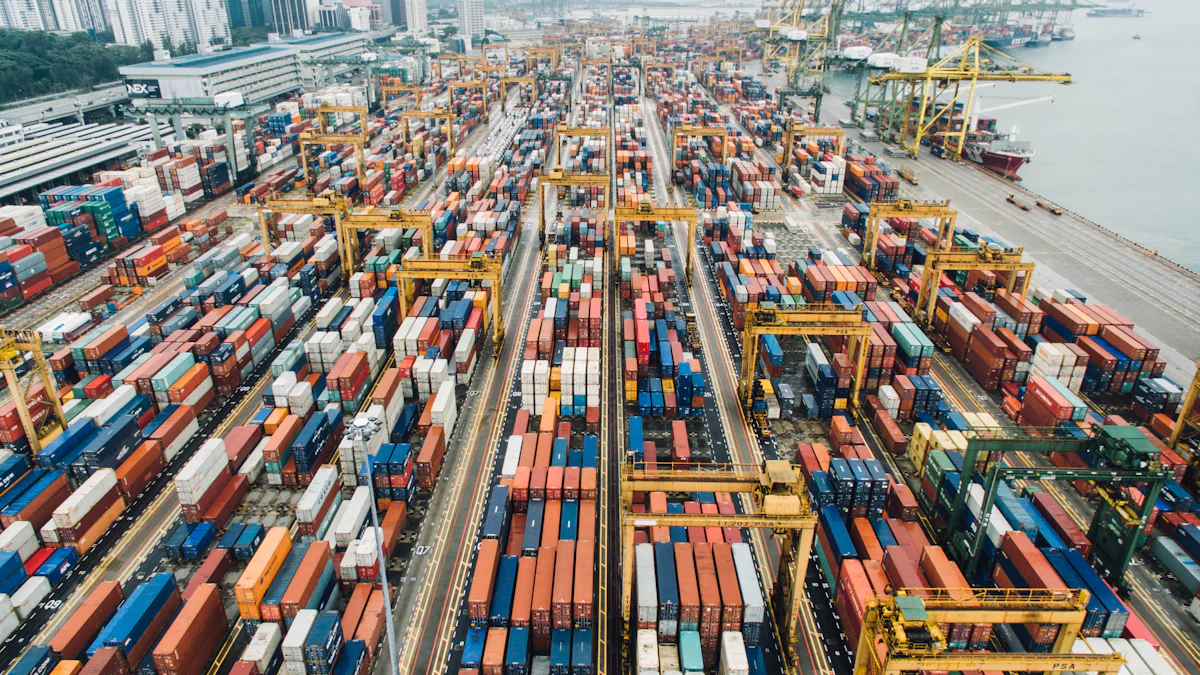From Ports to Pueblos: Tracing Mexico's Logistics Revolution

The current state of logistics in Mexico is characterized by a crucial role in the nation's economy. The sector supports international trade and contributes significantly to GDP. The logistics market, including last-mile delivery, is valued at about US$15.5 billion and is expected to grow at a compound annual growth rate of more than 6.5% over the next five years. Mexico's logistics industry faces challenges such as the all-time low availability of warehousing space, infrastructure constraints, and talent shortages. This guide aims to provide valuable insights into the opportunities and challenges within Mexico's logistics sector.
The Current State of Logistics in Mexico
Historical Context
Evolution of Logistics in Mexico
Logistics in Mexico has evolved significantly over the past few decades. Initially, logistics operations relied heavily on manual processes and local transportation networks. The introduction of modern technologies and international trade agreements marked a turning point. These advancements transformed logistics into a more efficient and integrated system.
Key Milestones
Several key milestones have shaped the logistics landscape in Mexico. The North American Free Trade Agreement (NAFTA) in 1994 opened new avenues for cross-border trade. The recent inauguration of the first phase of the Mayan Train project aims to boost Mexico's position as a logistics hub. This project enhances trade capabilities through connectivity with the Interoceanic Corridor.
The Current State of Logistics in Mexico
Major Players
The logistics sector in Mexico features several major players. Companies like DHL, FedEx, and UPS dominate the market. Local companies such as Estafeta and Redpack also play crucial roles. These companies offer a wide range of services, including freight forwarding, warehousing, and last-mile delivery.
Key Infrastructure
Key infrastructure supports the logistics industry in Mexico. The country boasts an extensive network of roads, railways, and ports. Major ports like Veracruz and Manzanillo handle significant cargo volumes. Airports in Mexico City and Guadalajara serve as critical hubs for air freight. However, infrastructure constraints remain a challenge for the industry.
Economic Impact
Contribution to GDP
The logistics sector contributes significantly to Mexico's GDP. The industry supports international trade and domestic distribution. The logistics market, including last-mile delivery, is valued at about US$15.5 billion. This sector is expected to grow at a compound annual growth rate of more than 6.5% over the next five years.
Employment Statistics
Employment statistics highlight the importance of logistics in Mexico. The sector provides jobs for thousands of people across various roles. These roles include drivers, warehouse workers, and logistics managers. The industry faces challenges in recruiting skilled labor, particularly drivers and logistics personnel.
Opportunities in Mexico's Logistics Sector

Strategic Location
Proximity to the U.S.
Mexico's proximity to the U.S. offers a significant advantage for logistics operations. Companies can reduce transportation costs and delivery times by leveraging this geographical benefit. The close distance between the two countries facilitates seamless cross-border trade. This strategic location enhances Mexico's role in the global supply chain.
Access to Both Oceans
Mexico's access to both the Pacific and Atlantic Oceans provides unique logistical advantages. Ports on both coasts enable efficient shipping routes to various international markets. This dual-ocean access supports diverse trade opportunities, making Mexico an attractive hub for global logistics. Efficient port facilities enhance the country's connectivity with international trade partners.
Trade Agreements
USMCA
The United States-Mexico-Canada Agreement (USMCA) strengthens Mexico's position in North American trade. This agreement facilitates duty-free access to the U.S. market, benefiting logistics operations. Companies can capitalize on streamlined customs procedures and reduced tariffs. USMCA enhances Mexico's attractiveness for nearshoring opportunities.
Other International Agreements
Mexico has established several other international trade agreements that bolster its logistics sector. Agreements with the European Union and countries in Latin America expand Mexico's trade network. These agreements provide preferential market access and foster economic cooperation. Mexico's extensive trade agreements enhance its role as a global logistics hub.
Growing Industries
Manufacturing
The manufacturing industry in Mexico presents significant opportunities for logistics growth. Mexico's cost-competitive labor force attracts foreign investment in manufacturing. Efficient logistics operations support the distribution of manufactured goods to international markets. The strategic location of manufacturing hubs enhances supply chain efficiency.
E-commerce
The e-commerce sector in Mexico is experiencing rapid growth, driving demand for logistics services. Increased online shopping requires efficient last-mile delivery solutions. Companies must adapt to the evolving landscape of e-commerce logistics. Technological advancements and innovative strategies support the growth of e-commerce logistics in Mexico.
Challenges in Mexico's Logistics Sector

Infrastructure Issues
Road and Rail Networks
Mexico's logistics sector faces significant challenges with road and rail networks. The country's extensive road network suffers from poor maintenance and congestion. Many roads, especially in rural areas, remain in disrepair, causing delays and increasing transportation costs. The rail network, although extensive, lacks modernization. Outdated rail infrastructure limits the efficiency of freight transport. Enhancing these networks requires substantial investment and strategic planning.
Port Facilities
Port facilities in Mexico also present challenges for the logistics sector. Major ports like Veracruz and Manzanillo experience frequent congestion. Surging demand for Asian cars strains transportation infrastructure, leading to delays. Efficient port operations are crucial for maintaining Mexico's role in global trade. However, inadequate port facilities hinder the smooth flow of goods. Addressing these issues involves upgrading port infrastructure and improving operational efficiency.
Regulatory and Bureaucratic Hurdles
Customs Procedures
Customs procedures in Mexico pose significant hurdles for logistics operations. Complex and time-consuming customs regulations delay the clearance of goods. Companies face challenges navigating the intricate documentation requirements. These delays impact the overall efficiency of the supply chain. Streamlining customs procedures is essential for enhancing Mexico's logistics capabilities.
Compliance Requirements
Compliance requirements add another layer of complexity to Mexico's logistics sector. Companies must adhere to various regulatory standards, including product standards and labor laws. Meeting these requirements often involves extensive paperwork and administrative processes. Non-compliance can result in penalties and disruptions to logistics operations. Simplifying compliance processes can help businesses operate more efficiently.
Security Concerns
Cargo Theft
Cargo theft remains a significant concern in Mexico's logistics industry. Car robberies accompanied by violence remain high, especially in the southern part of the country. Federal states like Mexico and Morelos report the highest annual rates of violent car robberies. Cargo theft grew 9.4% during January-September 2023 compared to the same period in the previous year. Implementing robust security measures is crucial for protecting valuable goods in transit.
Safety of Logistics Personnel
The safety of logistics personnel is another critical issue. Road violence poses threats to drivers and limits investments in specific regions. Ensuring the safety of logistics personnel requires comprehensive security strategies. Companies must invest in training and protective measures to safeguard their workforce. Addressing security concerns is vital for maintaining a reliable logistics network.
Solutions and Strategies
Government Initiatives
Infrastructure Investments
The Mexican government has prioritized infrastructure investments to address logistical challenges. Significant funds have been allocated to improve road networks, railways, and ports. These investments aim to enhance the efficiency of freight transport. Upgraded infrastructure will reduce transportation costs and delays. Improved roads and railways will facilitate smoother logistics operations.
Policy Reforms
Policy reforms play a crucial role in streamlining logistics. The government has introduced measures to simplify customs procedures. These reforms aim to reduce the time required for goods clearance. Simplified processes will enhance the overall efficiency of supply chains. The government also focuses on reducing bureaucratic hurdles. These efforts aim to create a more business-friendly environment for logistics companies.
Technological Innovations
Digitalization
Digitalization transforms the logistics sector in Mexico. Advanced technologies improve the tracking and management of shipments. Real-time data allows companies to monitor their supply chains more effectively. Digital platforms streamline communication between different stakeholders. Enhanced visibility leads to better decision-making and reduced operational costs.
Automation
Automation offers significant benefits for logistics operations. Automated systems increase the speed and accuracy of various processes. Warehousing operations benefit from automated sorting and handling systems. These technologies reduce the reliance on manual labor. Automation also enhances the safety and efficiency of logistics personnel. Companies can achieve higher productivity and lower error rates through automation.
Best Practices for Businesses
Risk Management
Effective risk management is essential for successful logistics operations. Companies must identify potential risks and develop mitigation strategies. Risk assessments help in understanding vulnerabilities within the supply chain. Implementing robust security measures can prevent cargo theft. Regular training and updates ensure that employees are prepared for any contingencies.
Efficient Supply Chain Management
Efficient supply chain management optimizes logistics performance. Companies should focus on streamlining their processes to reduce delays. Collaboration with reliable partners ensures smooth operations. Utilizing advanced technologies can enhance supply chain visibility. Efficient management practices lead to cost savings and improved customer satisfaction.
Experts concur that as Mexico enters a new global paradigm as an important logistical actor, the logistics industry must be efficient and rapid in adapting to the new challenges and trends that are shaping logistics in the country.
Porter's five forces analysis assists stakeholders in assessing the impact of new entrants, competitive rivalry, supplier power, buyer power, and the threat of substitution. This analysis helps stakeholders analyze the level of competition within the Mexico freight and logistics industry and its attractiveness.
Effective logistics is crucial for clients to transport their machinery and products to Mexico. Infrastructure also plays a vital role, and there are notable deficiencies in port facilities and road networks.
Change is often met with resistance but, eventually, everything settles into place. Challenges persist, particularly with customs restrictions, port issues, and logistical constraints. Logistics in Mexico is complicated by port congestion, inadequate infrastructure, and complex customs processes. These issues contribute to high costs. Some terminals recently announced tariff increases, exacerbating client dissatisfaction with expensive service. Ideally, high prices would be offset by excellent service, but Mexico faces high costs coupled with less-than-satisfactory service.
Mexico's logistics sector offers significant opportunities and faces notable challenges. The strategic location, cost-competitive labor force, and proximity to the U.S. position Mexico as a favorable destination for foreign investment and nearshoring activities. However, infrastructure constraints, security concerns, and regulatory hurdles present substantial obstacles.
The future of Mexico's logistics sector depends on adaptability and innovation. Investment in infrastructure and technology will be crucial. Stakeholders must address operational inefficiencies and expand transport networks to accommodate increasing freight volumes.
Call to Action: Stakeholders should invest in modernizing infrastructure and enhancing security measures. Collaboration between public and private sectors is essential for leveraging Mexico's potential in the global logistics landscape.
See Also
Unveiling Top Global Logistics Companies: The Definitive Guide
Exploring Future Innovations in Logistics Technology
Achieving Manufacturing Success with Lean Logistics Navigation
Mastering Sustainable Supply Chain Transportation Strategies
